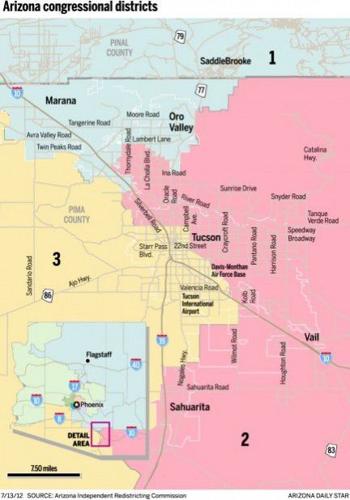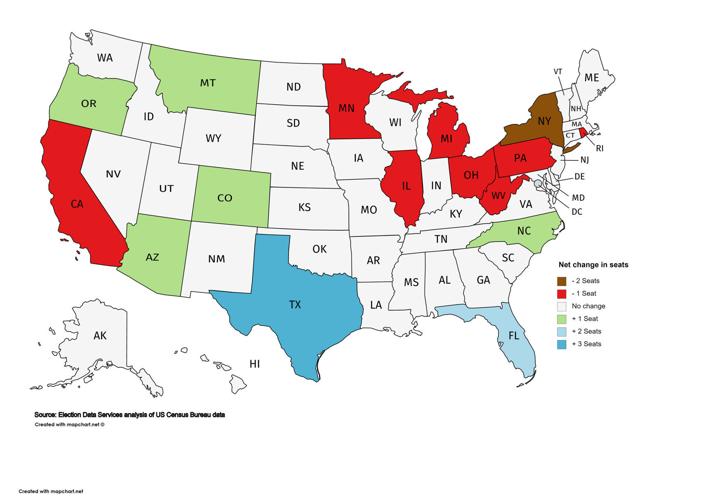PHOENIX — All those folks fleeing to Arizona from elsewhere put the state on track to pick up a 10th seat in the U.S. House of Representatives beginning in 2022.
That’s going to result in political jockeying among current and would-be federal lawmakers, as current members of Congress weigh whether to seek reelection in their own redrawn district or run in another.
There’s also the potential for political musical chairs, as there will be not just an open race for governor, but GOP lawmakers eyeing a chance to oust newly elected U.S. Sen. Mark Kelly in 2022.
All that is the result of new preliminary estimates from the U.S. Census Bureau that show Arizona’s population has increased by slightly more than a million since the official decennial count in 2010.
That’s a growth rate of 16.1%, the fifth-highest in the nation.
By contrast, the entire country grew at just 6.7%. Only Utah, Texas, Idaho and Nevada had greater decade-over-decade growth than the Grand Canyon State.
That’s important because the House has a fixed number of representatives at 435. So if Arizona is growing much faster than much of the rest of the country, it should get a bigger voice in that chamber. And states that haven’t grown as fast or whose populations have shrunk would lose.
Only thing is, it’s not a matter of simple math.
On paper, the current national population of nearly 329,500,000 would translate out neatly to individual congressional districts of about 757,434 people.
But the U.S. Constitution requires that each state have at least one representative, points out Kimball Brace, president of Election Data Services.
So Vermont gets one, as do Wyoming, North Dakota and Alaska.
There’s also the fact that the population of the District of Columbia, estimated at about 713,000, effectively doesn’t count as it is not entitled to any representation at all.
Factoring all that out, Brace figures Arizona with its growth of more than a million people since 2010 will get one more seat.
The biggest gainer is expected to be Texas, which Kimball figures will add three seats, bringing its representation in the House up to 39. That’s based on adding more than 4.2 million new residents in the past decade.
Florida also is likely to pick up two more seats, moving to 29 representatives.
And along with Arizona, other states gaining a seat are Colorado, Montana, North Carolina and Oregon.
But where there are winners — and a 435-seat maximum — there have to be losers.
With the Census Bureau reporting that the South and West held 14 of the 15 cities with the largest population gains in 2018, the personal-finance website WalletHub released its report on 2019’s Fastest-Growing Cities in America as well as accompanying videos. To determine where the most rapid local economic growth occurred over a period of seven years, WalletHub compared 515 U.S. cities across 17 key metrics. The data set ranges from population growth to college-educated population growth to unemployment rate decrease. In addition, we produced a separate ranking by city size.
Brace said New York, which lost more than 41,000 residents, according to the latest estimate, will drop at least one of its 27 seats in the House. And he figures it actually could be a net loss of two.
That’s due to the Trump administration’s bid to exclude from the count those people who are not lawfully present in the United States.
The U.S. Supreme Court late last week sidestepped the legality of that move, with the majority of the justices concluding the case was not ripe for review because the administration had not said which individuals it wanted to exclude from the count. That potentially paves the way for a future ruling.
Brace figures if undocumented individuals are excluded, that likely would cost New York a second seat. And the winner in that scenario appears to be Alabama, which might be able to hang on to all of its seven representatives.
California also is likely to lose a representative, leaving it with 52 members in the House. That still leaves it far ahead of anywhere else.
Also declining would be Minnesota, Michigan, Illinois, Ohio, West Virginia, Pennsylvania and Rhode Island.
The analysis by Election Data Services of the newly released data shows that if Arizona gets 10 seats in the House, that means 10 districts each with about 742,000 residents to meet the legal mandate for equal population.
But the fact is that all parts of the state haven’t grown equally fast in the past decade.
The biggest growth rates have been in the Phoenix metropolitan area, extending into parts of Pinal County. So it’s likely that a new congressional seat would have to be carved into that area.
That means even more clout for Central Arizona: Six of the state’s nine congressional districts include parts of Maricopa County; add Pinal into the mix and it’s seven.
It ultimately will be up to Arizona’s Independent Redistricting Commission to decide how to redivide the state.
The bipartisan voter-created panel is required to consider a variety of factors, like respecting communities of interest and using county boundaries when possible.
Commissioners also are required to create as many politically competitive districts as possible.
That means there is a mandate of sorts to take what have proven to be “safe” districts, like those occupied by Republican Andy Biggs and Democrat Raúl Grijalva, and find ways to try to even them up by party registration.
The new lines, by definition, won’t match the existing districts.
So incumbents will have to decide whether to continue to run in the district where they live, or another district, as nothing in federal law requires a member of Congress to live in her or his district, though that is usually politically advisable.
Complicating matters is what else is up for grabs in 2022.
Kelly, a Tucson Democrat elected this year to serve the last two years of the term of Sen. John McCain, will have to seek his own six-year term. And that could prove tempting to Republicans in Congress such as Biggs and David Schweikert.





